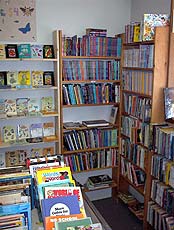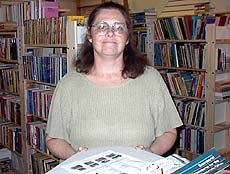|
Features |
Invention Mysteries | Announcements
|
Honors
& Awards
The
Chamber Report | Main
Street Corner News | Job
Hunt
Classifieds |
Calendar |
Lottery
Numbers | Business
News Elsewhere | Tech
News Elsewhere |
|
Features
|
|
Local organizations support
city and county tax increases
[MARCH
28, 2003]
Expressing a commitment to
the future of Lincoln and Logan County, local organizations have
announced their endorsement of two tax measures on the April 1
ballot.
|
|
The Logan County Farm Bureau, the
Lincoln/Logan Chamber of Commerce and the Logan County Regional
Planning Commission support the Logan County economic development
tax. They also favor the one-half percent increase (from 6.25
percent to 6.75 percent) in the Lincoln
sales tax for infrastructure improvements to benefit economic
development.
Logan
County Economic Development tax
"Lincoln and Logan County need new jobs
which can be created by business expansion and the attraction of new
businesses," said Jim Drew, Logan County Farm Bureau Executive
Director. "These jobs are necessary for many residents, including
farm families who often find that family members need to bring in
income from non-farm jobs," he said.

According to Dale Voyles, chairman of
Logan County Board, "The economic development tax will be used for
salaries and promoting economic development."
"If we don't bring in new business to
share the tax burden, it will rest on the shoulders of the
residents," said Bob Pharis, Farm Bureau board member. "The one
thing we know for sure, if Lincoln and Logan County does not
encourage growth and new business, taxes for all residents will
increase to cover increased cost of services needed."
[to top of second column in
this article] |

"These taxes are an investment in
the future of our community," said Bobbi Abbott, executive
director of the chamber. "They will provide the means to
expand opportunities for growth."
Lincoln
sales tax
"A 'yes' vote for the city of Lincoln
sales tax increase will assist our city in accomplishing much-needed
infrastructure projects which won't be realized anytime soon if the
tax increase is not approved," said Mayor Beth Davis.
"Logan
County communities will be paying tribute to the past 150 years with
sesquicentennial celebrations," said Abbott. "At the same time, we
need to focus on our future by voting 'yes' to the tax proposals on
April 1."
[Sponsored by the
Lincoln/Logan Chamber of Commerce and the Logan County Farm Bureau
in support of a Lincoln and Logan County tax increase]
 |
|
|
New and used book
store
opens on square
[MARCH
27, 2003]
Now & Then Books, which
stocks a mix of new and used paperbacks and hardbacks, is open for
business at 107 S. Kickapoo, next door to The Treasure Chest in the
Griesheim Building.
|
|
"I guess you have to love reading first
of all," said co-owner Venetia Shaffer in explaining why her family
went into the book-selling business. "Half the fun is buying the
books to put in the store."
With husband Paul and son Philip,
Shaffer opened the business on Feb. 17. She and Philip run it during
the week. Paul, who has been a consultant for State Farm Insurance
almost two years, works with Venetia on weekends. Daughter Sarah,
14, a high school freshman, completes the family. Eventually, plans
are for Philip to run the store almost exclusively.
Hours for Now & Then Books are 10 a.m.
to 5 or 6 p.m. Monday through Saturday. A hand-lettered sign in the
window reads, "If the light's on, come on in." Other notices promote
instructional books for spring projects and "Coming soon: Handmade
hemp bracelets/chokers. Made to order."
The store currently stocks
approximately 8,000 books arranged by subject matter and sometimes
by format. Children's books are in the front of the store. Other
sections feature history, horror, fiction, mystery, sci-fi/fantasy,
romance, humor, psychology/sociology, action, Westerns, crafts and
New Age. A few music CDs are also in stock. Because of shelf size,
larger books are placed in special sections or on top of shelving
units. A former changing room at the rear of the store houses
hardback fiction.

New books comprise about 10 percent of
the current stock. Venetia Shaffer said she plans to increase that
percentage. "I'm finding they're the ones that are going out the
door," she explained.
The majority of paperbacks and many of
the hardbacks are offered at half price. It all depends on what the
Shaffers have to pay. They buy from a variety of sources, such as
wholesalers and auctions. "Anyplace that sells books," Venetia
Shaffer commented. "If we can get them at a reasonable price, we buy
them." She said she has accepted a few books on consignment and
would consider more.
The Shaffers' first stock came from
wholesalers in Oregon and Maryland. At that time they bought books
by the pallet but sometimes found they had half a dozen copies of
the same title. Now they hand pick to fill particular slots and
avoid duplicates.
[to top of second column in
this article] |

[Photos by Lynn Spellman]
Venetia Shaffer
The Shaffers entered the book business
about 10 years ago in Bedford, Pa. At that time they were operating
a bakery-delicatessen. Paul Shaffer got the idea of stocking books
along a long hall that led to the bathroom. Eventually, the books
sold better than the food, so the family closed the bakery-deli and
opened a bookstore.
After about three years in the book
business in Pennsylvania, the Shaffers moved to Brown Deer, Wis.,
near Milwaukee, and put their books in storage. When Paul moved to
Illinois to work for State Farm, they started to look for a place in
the area to live, checking out Bloomington, Normal and nearby towns.
Venetia said as soon as she saw Lincoln's courthouse square, she was
a goner. "I fell in love with the town," she exclaimed. "I don't
know why, but this reminds me of Mayberry."
Philip Shaffer graduated from high
school in Wisconsin in 2002, Sarah began at Lincoln Community High
School in the fall, and in January Venetia quit her job in Wisconsin
and moved permanently to Lincoln, glad to be done with the four-hour
commute. In January also the family rented 107 S. Kickapoo from
Harris & Harris and began moving in stock. It took a month and a
half to get set up.
The biggest sellers so far have been
small activity books for children, put out by Dover. These go for $1
apiece or five for $4. Instructional books have also sold well.
Venetia Shaffer said several types of books are particular targets
on buying trips. For example, craft books are a specialty, and she
is looking for more cookbooks. The family is also working on the
history collection but finds the books difficult to come by.
"Mystery is my husband's baby," Shaffer added, and he has amassed
quite a number.
Not all the 8,000 books in the store
are on display. Duplicates and some older volumes are warehoused at
the back.
All the
Shaffers are book lovers, and that is a major motivation for opening
a bookstore. Another is meeting people. Venetia Shaffer said that
she enjoys talking with customers and meeting new people in the
community.
[Lynn
Spellman]
|
|
|
Invention Mysteries
TM
Self-syndicated
weekly newspaper column |
|
We might have lost World War II
if not for this little-known 'invention'
By Paul
Niemann
[MARCH
27, 2003]
In war, the side with the superior level of intelligence
has a major advantage, as does the side with the most effective use
of communications.
|
|
This story delves
into how the use of a certain communications tool influenced World
War II. This "invention," though not patentable, is probably more
native to America than apple pie and baseball.
It was used in every
assault the U.S. Marines conducted in the Pacific from 1942 to 1945
-- Guadalcanal, Tarawa, Peleliu and Iwo Jima. It was used in all six
Marine divisions, Marine Raider battalions and Marine parachute
units, enabling our men to transmit messages by telephone and radio
in a code the Japanese never broke.
Without it, the
Marines would never have taken Iwo Jima, according to Maj. Howard
Connor of the 5th Marine Division.
So what is this great
"invention" that helped us win World War II?
The answer:
Navaho code talkers. These code talkers were Navaho Indians who were
recruited to transmit and interpret messages during the war.
The Germans had the
Enigma machine as their code system, but it was no match for the
Navajo code talkers. The syntax and tonal qualities, not to mention
dialects, make the Navaho code unintelligible to anyone without
extensive exposure and training. It has no alphabet or symbols, and
it is spoken only on the Navajo lands of the American Southwest. One
estimate indicates that less than 30 non-Navajos, none of them
Japanese, could understand the language at the outbreak of World War
II.
How important to the
American war effort were the Navaho code talkers?
Maj. Connor had six
Navajo code talkers working around the clock during the first two
days of the battle of Iwo Jima. Those six sent and received over 800
messages, all without error.
The subject of a 2002
Hollywood movie called "Windtalkers," the Navaho code talkers' code
is the only unbroken code in modern military history. The code
enabled American translators stationed outside the United States to
decipher the code in minutes, whereas other codes would take
approximately two hours to decipher. It would take only 20 seconds
for the Navaho code talkers to decode a three-line English message,
whereas machines required 30 minutes to perform the same job.
[to top of second column in this
article]
|
So how did the Navaho
code talkers go virtually unnoticed for half a century after the war
had ended?
Navajo remained
potentially valuable as code even after the war. For that reason,
the code talkers, whose skill and courage saved both American lives
and military engagements, only recently earned recognition from the
U.S. government and the public. They were honored in September of
1992 at the Pentagon.
Thirty-five Navajo
code talkers, all veterans of the U.S. Marine Corps, and their
families traveled from their homes on the Navajo reservation, which
includes parts of Arizona, New Mexico and Utah, to attend the
dedication of the Navajo code talker exhibit, which is a regular
stop on the Pentagon tour. The exhibit includes a display of
photographs, equipment and the original code, along with an
explanation of how the code worked.
Who was this
visionary Navaho individual who came up with this brilliant plan to
use their native language as code in World War II?
The idea actually
came from an American named Philip Johnston, the son of a missionary
to the Navajos and one of the few non-Navajos who spoke their
language fluently. Johnston, reared on the Navajo reservation, was a
World War I veteran who knew of the military's search for a code
that would withstand all attempts to decipher it. He also knew that
Native American languages -- notably Choctaw -- had been used in
World War I to encode messages.
Sources: The History
Channel, Naval Historical Center of the Department of the Navy
[Paul Niemann]
Paul Niemann
is a contributing author to Inventors' Digest magazine and he also
runs MarketLaunchers.com,
helping people in the marketing of their new product ideas. He can
be reached at niemann7@aol.com.
Last week's column in LDN:
"The case of the
missing 'monkey'" |
|
|
Eagle continues open for
business
[MARCH
19, 2003]
Rumors that the Eagle store
in Lincoln may be closing are completely untrue, according to a
company vice president.
|
|
Pat Flatley, vice president of
information technology, said in a telephone interview that the "tons
of rumors" are false. "We're not closing; we're not closing the
chain," he emphasized.
"I get calls and e-mails all day long
from customers, who are happy to hear that we are not closing,"
Flatley continued. He said Eagle employees are among those who have
spread the rumors, and the company has requested that they
discontinue doing so.
|
Without
supplying any statistics, Flatley said he believes Lincoln sales
have been affected by the rumors. Customers who believe the grocery
store is already closed go elsewhere to shop. However, he said he
was in the Lincoln store on Saturday, and Lincoln manager Barb
Pollock reported that sales are beginning to recover.
[Lynn
Spellman]
|
|
|
Lincoln and Logan County
bucking the trends
Economic growth slow but steady
[MARCH
14, 2003]
Over the course of the last
18 months many people have been quite concerned about the economy in
Logan County. With the closing of the Lincoln Developmental Center
and a couple of retail businesses going under, the rumors began to
swirl. However, not all the news is bad news. In fact, a case may be
made that Lincoln is not only bucking those negative local trends,
but also bucking those depressing national trends as well.
Unemployment rates that are climbing, taxes being raised and not
much talk about any economic prosperity may have you wondering: How
could Lincoln be curbing those indicators?
|
|
But a closer look at what is actually
happening in Lincoln and the surrounding area seems to indicate that
reports of our demise may have been greatly exaggerated. Take
Precision Products for example. Bob Jones is reporting that PP has
actually added 22 new jobs just during the month of February, not
exactly your growth month. And Ed Block over at Saint-Gobain
Containers is reporting the creation of 12 new positions at their
plant. Main Street Lincoln Director Cindy McLaughlin has cited at
least six individuals who have applied for grants to start new
businesses in the Courthouse Square Historic District. Several other
local businesses plan to expand or add jobs in the near future. Bill
Campbell and Charlie Lee over at the IGA grocery store are planning
a 5,000-square-foot addition as soon as possible.
The growth is not just limited to our
city's borders, as business seems to be doing well in the county
too. Mark Hughes over at Inland Tool in Mount Pulaski has just added
a new shift. That has meant the establishment of 10 new jobs. In
Atlanta, nine of the 10 houses built on the golf course have been
sold, while two new ones are currently under construction. In
addition, three new ones are scheduled to begin construction in the
spring.
We're sure that the math majors and the
bean counters will be quick to remind us all that these reports will
not make up for the loss of the LDC. While that may be true, you
have to start somewhere. We commend these businesses for their
vision and foresight during perilous times. We're sure those
decisions must have been easier when the stock market was flying
along at record levels.
[to top of second column in this
article]
|
Keep in mind that the companies
mentioned here are only the ones who have agreed to go public
with their plans and additions. There are others with deals
pending who don't want publicity until deals are done and
contracts are signed. We suspect that there are several people
wanting to relocate, remodel and or increase the size of their
businesses, judging by the wealth of calls we're getting. We
also believe that some people want to come to Logan County to
set up shop. We are predicting that as the weather warms we
will be bombarded with requests for even more economic
development projects in our community and in our area.
And why
wouldn't that be so? We have maintained for years that Logan County
may be one of the best kept secrets in the state, if not the nation.
For the second year in a row, Illinois was chosen as the No. 1 state
for economic development in the country! Couple that with the
tourist boom we're expected to see in the years ahead, and things
might not be nearly as gloomy as the doom, gloom and naysayers would
have you believe. At least these recent reports seem to indicate
that Logan County may be bucking the trends!
[Jeff Mayfield, economic
development director] |
|
- Is this
the right time to go into business?
[Click
here for article by Jim Youngquist.]
|
|
|
Announcements
|
|
|
Honors
& Awards
|
|
|
The
Chamber Report
|
|
Lincoln/Logan
County Chamber of Commerce
Bobbi
Abbott, Executive Director
303
S. Kickapoo St.
Lincoln,
IL 62656
(217)
735-2385
chamber@lincolnillinois.com
www.lincolnillinois.com
|
The
local chamber of commerce is a catalyst for community progress, bringing
business and professional people together to work for the common
good of Lincoln and Logan County.
|
|
|
Main
Street Corner News
|
|
Main
Street Lincoln
Cindy McLaughlin, Program Manager
303
S. Kickapoo
Lincoln,
IL 62656
|
Phone:
(217) 732-2929
Fax:
(217) 735-9205
E-mail:
manager@mainstreetlincoln.com |
|
|
Back
to top
|
News
| Sports
| Business
| Rural
Review |
Teaching
& Learning |
Home
and Family |
Tourism | Obituaries
Community |
Perspectives |
Law
& Courts |
Leisure Time |
Spiritual
Life | Health
& Fitness |
Calendar
Letters
to the Editor
|
|